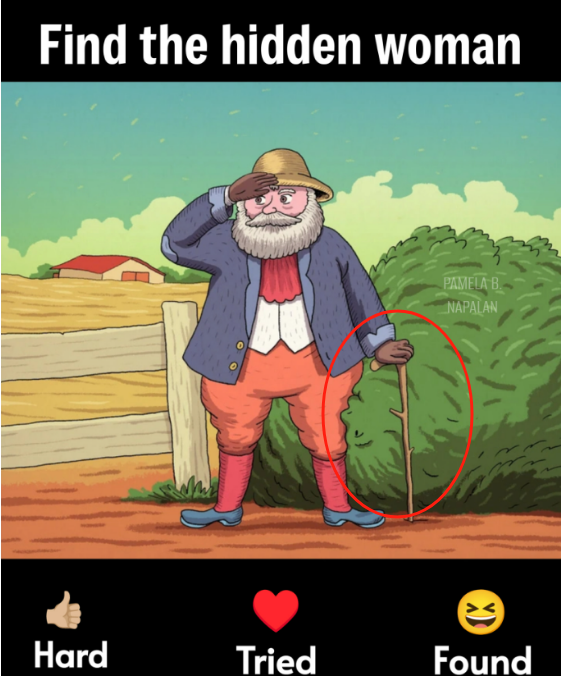Unlocking the Hidden Woman Illusion: A Step-by-Step Guide to Optical Puzzle Mastery
Why Optical Illusions Captivate Our Minds
Optical illusions like the “Hidden Woman” puzzle mesmerize us because they challenge the brain’s natural drive to find familiar patterns. When you first glance at the kindly old farmer standing beside a rustic fence and hedge, you see only pastoral calm. Yet with a little effort, a second figure—a woman’s face—materializes from the background brushwork. This delightful “aha!” moment taps into our innate pattern-seeking tendencies and offers a playful workout for our perception.

Understanding Pareidolia: The Science Behind Seeing Faces
Pareidolia is the psychological phenomenon that makes us see faces in clouds, houses, or tree bark. In the Hidden Woman illusion:
- Contour Matching: The hedge’s curving lines double as the woman’s long hair.
- Figure–Ground Ambiguity: The man’s form occupies the “figure” layer initially, while the hidden face retreats into the “ground.” Skillful shading invites your visual system to flip those layers.
- Gestalt Grouping: Your brain naturally groups discrete shapes—bush leaves, fence slats—into meaningful wholes, in this case a female profile.
By learning how pareidolia works, you can sharpen your ability to spot concealed elements in a variety of images.
Step-by-Step Hunt: How to Find the Hidden Woman
Follow these targeted strategies to reveal the secret face:
- Relax Your Gaze: Don’t stare directly at the man. Instead, soften your focus and let your peripheral vision roam over the hedge area behind him.
- Trace Major Shapes: Mentally outline the big bush behind the farmer. Notice how its curved top could form a forehead and hairline.
- Seek Key Facial Features: Look for an eye—scan for a dark leaf-shaped reflection. Once you locate the eye, the nose bridge falls into place down a lighter shoot.
- Follow the Hairline: The thicker branches on the right become the sweep of hair framing her cheek.
- Zoom Out and In: If viewing digitally, slightly zoom out to blur distracting details, then zoom in on promising patches to confirm the chin and jawline.
With each tip, the woman’s visage should grow clearer until the illusion clicks into view.

Tips for Spotting Other Hidden Figures
Once you master this puzzle, try these general techniques:
- Rotate the Image: A 90° turn can turn random patterns into familiar shapes.
- Shade or Overlay Lines: Light pencil tracings can help delineate ambiguous boundaries.
- Change Distance: Step a few feet back—your visual system integrates shapes differently at different scales.
- Use a Mirror: Holding the image to a mirror sometimes highlights mirrored symmetry you’d miss head-on.
Practicing these tactics turns you into a bona fide illusion detective.
Creating Your Own Hidden-Figure Puzzles
Fancy crafting an optical puzzle for friends? Here’s how:
- Choose a Strong Silhouette: Start with a simple portrait or object outline—faces work especially well.
- Overlay Natural Textures: Scan foliage, marble, or woodgrain and layer it over your silhouette, adjusting opacity until internal details peek through.
- Simplify Contrasts: Reduce the number of colors or shades to heighten ambiguity.
- Test with Strangers: Show early drafts to people unfamiliar with the concept. If they spot both images with minimal prompting, you’ve succeeded.
Designing these puzzles hones your artistic and psychological insight in equal measure.

Why Optical Puzzles Boost Brain Health
Engaging with illusions isn’t just fun—it has real cognitive benefits:
- Enhances Visual Acuity: Regular practice improves pattern recognition and detail discrimination.
- Strengthens Memory: Remembering hidden figures and how you found them reinforces neural pathways.
- Promotes Creative Thinking: Switching between two valid interpretations trains flexible, out-of-the-box problem-solving.
- Reduces Stress: Those “aha!” moments trigger small dopamine hits, giving your brain a satisfying reward.
Incorporating a few minutes of puzzle-solving into your daily routine can sharpen your senses and brighten your mood.

Conclusion: Turning Pastoral Scenes into Puzzling Adventures
The “Hidden Woman” illusion transforms a tranquil farm tableau into a captivating brain teaser. By understanding pareidolia, applying systematic search techniques, and practicing general illusion strategies, you can uncover the woman’s face and tackle ever more complex puzzles. Whether you’re a casual puzzler or a devoted illusionist, each hidden figure you reveal reinforces the secret power of perception—and reminds us that magic often lies just beneath the surface of the everyday.





